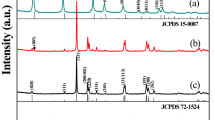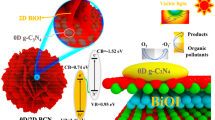Abstract
The contact degree of heterojunction plays a crucial role to the separating efficiency of photo-generated carriers. Herein, a nano-sheet like BiOBr/Bi24O31Br10 lattice heterojunction is firstly prepared from a simple solid-state chemical reaction. The phase transformation from BiOBr to BiOBr/Bi24O31Br10, then to pure Bi24O31Br10 can be realized simply by the thermal annealing process. Benefiting from the enhanced photoinduced carrier separation efficiency of the formed lattice heterojunction, the BiOBr/Bi24O31Br10 composite exhibites excellent photocatalytic capability to reduce CO2 to CO, which has a stable yield of CO (29.19 μmol g−1) after 5 h of continuous catalytic reaction, the reaction rate constants are 4.2 and 3.5 times higher than that of pure Bi24O31Br10 and BiOBr, respectively. Meanwhile, the heterostructures present super photocatalytic degradation ability for rhodamine B (RhB) under visible light. The mechanism of the photocatalytic reduction and oxidation process is systematically investigated and proposed. This work provides an effective strategy to design staggered heterojunction photocatalyst by a solvent-free method and reveals the mechanism of lattice heterostructure for boosting photocatalytic performance.
Graphical abstract







Similar content being viewed by others

References
Bai Y, Yang P, Wang L, Yang B, Xie H, Zhou Y, Ye L (2019) Ultrathin Bi4O5Br2 nanosheets for selective photocatalytic CO2 conversion into CO. Chem Eng J 360:473–482
Di J, Song P, Zhu C, Chen C, Xiong J, Duan M, Long R, Zhou W, Xu M, Kang L, Lin B, Liu D, Chen S, Liu C, Li H, Zhao Y, Li S, Yan Q, Song L, Liu Z (2020) Strain-engineering of Bi12O17Br2 nanotubes for boosting photocatalytic CO2 reduction. ACS Mater Lett 2:1025–1032
Gao P, Yang Y, Yin Z, Kang F, Fan W, Sheng J, Feng L, Liu Y, Du Z, Zhang L (2021) A critical review on bismuth oxyhalide based photocatalysis for pharmaceutical active compounds degradation: modifications, reactive sites, and challenges. J Hazard Mater 412:125186–125216
Guo J, Liu Y, Hao Y, Li Y, Wang X, Liu R, Li F (2018) Comparison of importance between separation efficiency and valence band position: the case of heterostructured Bi3O4Br/α-Bi2O3 photocatalysts. Appl Catal B Environ 224:841–853
Hao L, Huang H, Guo Y, Du X, Zhang Y (2017) Bismuth oxychloride homogeneous phasejunction BiOCl/Bi12O17Cl2 with unselectively efficient photocatalytic activity and mechanism insight. Appl Surf Sci 420:303–312
He Z, Huang J, Liu K, Tang X, Dai Y (2019) Fabrication of nanofibrous SiO/C/CoO composites with fast reaction kinetic and excellent structural stability for lithium storage. J Alloys Compd 811:151971–151983
Huang Y, Wang K, Guo T, Li J, Wu X, Zhang G (2020a) Construction of 2D/2D Bi2Se3/g-C3N4 nanocomposite with high interfacial charge separation and photo-heat conversion efficiency for selective photocatalytic CO2 reduction. Appl Catal B Environ 277:119232–119241
Jia X, Han Q, Liu H, Li S, Bi H (2020) A dual strategy to construct flowerlike S-scheme BiOBr/BiOAc1-xBrx heterojunction with enhanced visible-light photocatalytic activity. Chem Eng J 399:125701–125714
Jiang Y, Chen H, Li J, Liao J, Zhang H, Wang X, Kuang D (2020) Z-Scheme 2D/2D heterojunction of CsPbBr3/Bi2WO6 for improved photocatalytic CO2 reduction. Adv Funct Mater 31:2004293–2004301
Jin X, Xu Y, Zhou X, Lv C, Huang Q, Chen G, Xie H, Ge T, Cao J, Zhan J, Ye L (2021) Single-atom Fe triggers superb CO2 photoreduction on a bismuth-rich catalyst. ACS Mater Lett 3:364–371
Khodaeipour M, Haghighi M, Shabani M, Mohseni N (2020) Influence of fuel type and microwave combustion on in-situ fabrication of BimOnBrz mixed-phase nanostructured photocatalyst: effective sun-light photo-response ability in tetracycline degradation. J Hazard Mater 393:122462–122475
Li P, Zhou Z, Wang Q, Guo M, Chen S, Low J, Long R, Liu W, Ding P, Wu Y, Xiong Y (2020) Visible-light-driven nitrogen fixation catalyzed by Bi5O7Br nanostructures: enhanced performance by oxygen vacancies. J Am Chem Soc 142:12430–12439
Liu X, Su Y, Zhao Q, Du C, Liu Z (2016) Constructing Bi24O31Cl10/BiOCl heterojunction via a simple thermal annealing route for achieving enhanced photocatalytic activity and selectivity. Sci Rep 6:28689–28702
Liu Z, Wang Q, Cao D, Wang Y, Jin R, Gao S (2020) Vertical grown BiOI nanosheets on TiO2 NTs/Ti meshes toward enhanced photocatalytic performances. J Alloys Compd 820:153109–153115
Liu Y, Shen D, Zhang Q, Lin Y, Peng F (2021) Enhanced photocatalytic CO2 reduction in H2O vapor by atomically thin Bi2WO6 nanosheets with hydrophobic and nonpolar surface. Appl Catal B Environ 283:119630–119639
Lv X, Yan D, Lam FL, Ng YH, Yin S, An AK (2020) Solvothermal synthesis of copper-doped BiOBr microflowers with enhanced adsorption and visible-light driven photocatalytic degradation of norfloxacin. Chem Eng J 401:126012–126024
Ning S, Ding L, Lin Z, Lin Q, Zhang H, Lin H, Long J, Wang X (2016) One-pot fabrication of Bi3O4Cl/BiOCl plate-on-plate heterojunction with enhanced visible-light photocatalytic activity. Appl Catal B Environ 185:203–212
Qin Z, Chen L, Ma R, Tomovska R, Luo X, Xie X, Su T, Ji H (2020) TiO2/BiYO3 composites for enhanced photocatalytic hydrogen production. J Alloys Compd 836:155428–155435
Ren X, Gao M, Zhang Y, Zhang Z, Cao X, Wang B, Wang X (2020) Photocatalytic reduction of CO2 on BiOX: effect of halogen element type and surface oxygen vacancy mediated mechanism. Appl Catal B Environ 274:119063–119076
Shang J, Hao W, Lv X, Wang T, Wang X, Du Y, Dou S, Xie T, Wang D, Wang J (2014) Bismuth oxybromide with reasonable photocatalytic reduction activity under visible light. ACS Catal 4:954–961
Sun J, Li X, Zhao Q, Liu B (2021) Ultrathin nanoflake-assembled hierarchical BiOBr microflower with highly exposed 001 facets for efficient photocatalytic degradation of gaseous ortho-dichlorobenzene. Appl Catal B Environ 281:119478–119489
Tian F, Zhang Y, Li G, Liu Y, Chen R (2015) Thickness-tunable solvothermal synthesis of BiOCl nanosheets and their photosensitization catalytic performance. New J Chem 39:1274–1280
Wang L, Zhao X, Lv D, Liu C, Lai W, Sun C, Su Z, Xu X, Hao W, Dou S, Du Y (2020a) Promoted photocharge separation in 2D lateral epitaxial heterostructure for visible-light-driven CO2 photoreduction. Adv Mater 23:2004311–2004319
Wang S, Wang L, Huang W (2020b) Bismuth-based photocatalysts for solar energy conversion. J Mater Chem A 8:24307–24352
Wei W, Gong H, Sheng L, Wu H, Zhu S, Feng L, Li X, You W (2021) Highly efficient photocatalytic activity and mechanism of novel Er3+ and Tb3+ co-doped BiOBr/g-C3N5 towards sulfamethoxazole degradation. Ceram Int 47:24062–24072
Wu H, Zheng Z, Toe CY, Wen X, Hart JN, Amal R, Ng YH (2020) A pulse electrodeposited amorphous tunnel layer stabilises Cu2O for efficient photoelectrochemical water splitting under visible-light irradiation. Journal of Materials Chemistry A 8:5638–5646
Wu H, Kong XY, Wen X, Chai SP, Lovell EC, Tang J, Ng YH (2021a) Metal-organic framework decorated cuprous oxide nanowires for long-lived charges applied in selective photocatalytic CO2 reduction to CH4. Angew Chem Int Ed Engl 60:8455–8459
Wu Z, Shen J, Ma N, Li Z, Wu M, Xu D, Zhang S, Feng W, Zhu Y (2021b) Bi4O5Br2 nanosheets with vertical aligned facets for efficient visible-light-driven photodegradation of BPA. Appl Catal B Environ 286:119937–1199348
Xie J, Cao Y, Jia D, Li Y (2017) Dahlia-shaped BiOClxI1-x structures prepared by a facile solid-state method: evidence and mechanism of improved photocatalytic degradation of rhodamine B dye. J Colloid Interface Sci 503:115–123
Xie Z, Zhou J, Wang J, François-Xavier CP, Wintgens T (2019) Novel fenton-like catalyst γ-Cu-Al2O3-Bi12O15Cl6 with electron-poor Cu centre and electron-rich Bi centre for enhancement of phenolic compounds degradation and H2O2 utilization: the synergistic effects of σ-Cu-ligand, dual-reaction centres and oxygen vacancies. Appl Catal B Environ 253:28–40
Xie J, Cao Y, Hu J, Tang Y, Jia D (2020) A solvent-free strategy to realize the substitution of I− for IO3− in a BiOIO3 photocatalyst with an opposite charge transfer path. Green Chem 22:1424–1431
Xu Y, Jin X, Ge T, Xie H, Sun R, Su F, Li X, Ye L (2021) Realizing efficient CO2 photoreduction in Bi3O4Cl: constructing van der wals heterostructure with g-C3N4. Chem Eng J 409:128178–128187
Yang J, Xie T, Zhu Q, Wang J, Xu L, Liu C (2020) Boosting the photocatalytic activity of BiOX under solar light via selective crystal facet growth. J Mater Chem C 8:2579–2588
Yin J, Gao D, Zhu X, Liu X, Li H (2021) One-pot synthesis of 3D porous Bi7O9I3/N-doped graphene aerogel with enhanced photocatalytic activity for organic dye degradation in wastewater. Ceram Int 47:19556–19566
Zhang P, Huang Y, Rao Y, Chen M, Li X, Hou W, Lee S, Cao J (2021) Chemical etching fabrication of uniform mesoporous Bi@Bi2O3 nanospheres with enhanced visible light-induced photocatalytic oxidation performance for NOx. Chem Eng J 406:126910–126921
Zhou Y, Wang Z, Huang L, Zaman S, Lei K, Yue T, Li Z, You B, Xia B (2021) Engineering 2D photocatalysts toward carbon dioxide reduction. Adv Energy Mater 11:2003159–2003178
Zhu J, Li Y, Wang X, Zhao J, Wu Y, Li F (2019) Simultaneous phosphorylation and Bi modification of BiOBr for promoting photocatalytic CO2 reduction. ACS Sustainable Chem Eng 7:14953–14961
Zhu L, Wu Y, Wu S, Dong F, Xia J, Jiang B (2021) Tuning the active sites of atomically thin defective Bi12O17Cl2 via incorporation of subnanometer clusters. ACS Appl Mater Interfaces 13:9216–9223
Funding
This work was financially supported by the Natural Science Foundation of Xinjiang Autonomous Region (No. 2021D01C093), the Scientific Research Program of the Higher Education Institution of Xinjiang (No. XJEDU2019Y012), the Xinjiang Tianchi Doctoral Project (No. tcbs201933), and the Xinjiang University Doctoral Research Foundation (No. BS190228).
Author information
Authors and Affiliations
Corresponding authors
Ethics declarations
Conflict of interest
The authors declare no competing interests.
Additional information
Publisher's Note
Springer Nature remains neutral with regard to jurisdictional claims in published maps and institutional affiliations.
Supplementary Information
Rights and permissions
About this article
Cite this article
Feng, Y., Xie, J., Lu, Z. et al. Solid-state fabrication of BiOBr/Bi24O31Br10 lattice heterojunction for photocatalytic reduction of CO2 and degradation of RhB. J Nanopart Res 24, 27 (2022). https://doi.org/10.1007/s11051-021-05394-z
Received:
Accepted:
Published:
DOI: https://doi.org/10.1007/s11051-021-05394-z



